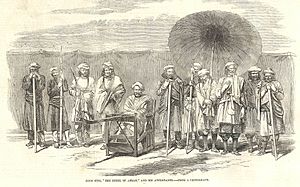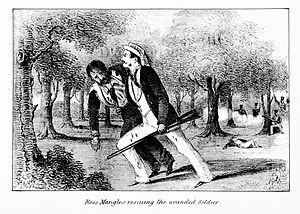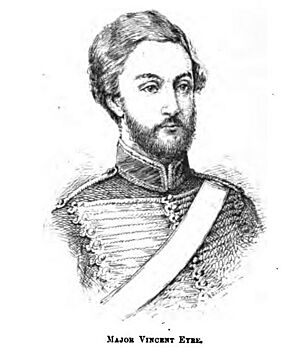Siege of Arrah facts for kids
Quick facts for kids Siege of Arrah |
|||||||
|---|---|---|---|---|---|---|---|
| Part of the Indian Rebellion of 1857 | |||||||
 Defence of the Arrah House, 1857 (1858) by William Tayler |
|||||||
|
|||||||
| Belligerents | |||||||
| Jagdishpur estate Mutinying Sepoys |
|||||||
| Commanders and leaders | |||||||
| Kunwar Singh Babu Amar Singh Hare Krishna Singh |
|||||||
| Strength | |||||||
| Besieged party: 68 First relief: 400 Second relief: 225 |
Mutinying Sepoys: 2,500 – 3,000 Kunwar Singh's forces: 8,000 (Estimated) |
||||||
| Casualties and losses | |||||||
| Besieged party: 1 wounded First relief: 170 killed 120 wounded Second relief: 2 killed |
Unknown | ||||||
The Siege of Arrah was an important event during the Indian Rebellion of 1857, also known as the Indian Mutiny. It happened from July 27 to August 3, 1857. A small group of 68 people defended a fortified building in Arrah, India. They were attacked by a much larger force of 2,500 to 3,000 mutinying soldiers and about 8,000 local fighters led by Kunwar Singh.
Two attempts were made to rescue the people trapped inside. The first rescue attempt failed, with many casualties. However, a second, smaller rescue mission, led by Major Vincent Eyre, succeeded. This group managed to scatter the attackers. Only one person from the besieged group was injured during the entire eight-day siege.
Contents
Why the Siege Happened
The Start of the Indian Mutiny
The Indian Mutiny began on May 10, 1857. It started when soldiers of the 3rd Bengal Light Cavalry rebelled in Meerut. This rebellion quickly spread across the Bengal Presidency, a large area controlled by the East India Company.
Arrah Before the Siege
Arrah was a town in the Shahabad district. It had British and European residents, including workers from the East India Company. There was also a local police force and a jail with many prisoners. Nearby, in Dinapore, were several regiments of soldiers. Many of these soldiers were from the Shahabad district itself. They were loyal to a local leader named Kunwar Singh.
Kunwar Singh was an older leader, about 80 years old. He had disagreements with the East India Company. He felt they had unfairly taken away his lands and money. People at the time described him as a proud leader who had lost his power because of foreign rule.
Preparing for Trouble
On June 8, 1857, a warning arrived in Arrah. It said that soldiers in Dinapore might rebel. The European families in Arrah decided to send their women and children to Dinapore for safety. Most other European men also left, but a few decided to stay and defend the town.
On June 11, a group of 50 soldiers from the Bengal Military Police Battalion arrived. These soldiers, known as Rattray's Sikhs, were led by Jemadar Hooken Singh. They were sent to help protect Arrah.
Fortifying the Building
Herwald Wake, the local magistrate, suggested preparing a strong place for defense. Richard Vicars Boyle, an engineer, began to fortify his two-story outbuilding. It was originally a billiard room. He filled the arches with bricks, leaving small holes to shoot through. He also stored food, water, and weapons inside.
Even though it was suggested to move everyone into Boyle's building right away, the idea was put off. People worried that leaving their main offices would cause chaos. Throughout June and July, news of the widespread rebellion arrived. Rumors of an attack on Arrah grew stronger. On July 17, a note warned that a mutiny would happen on July 25. It also said Kunwar Singh was involved. News of terrible events in Cawnpore also reached Arrah. Finally, on July 25, a letter from Dinapore warned that a revolt was expected that very day.
The Battle for Arrah
The Siege Begins
About 25 miles east of Arrah, in Dinapore, three regiments of Indian soldiers were stationed. The British military commander there, Major General George Lloyd, ordered these soldiers to hand in their weapon parts. On July 25, two regiments refused and fired on their officers. In the confusion, the third regiment was also fired upon. All three regiments then left Dinapore and headed towards Arrah. General Lloyd did not order his troops to chase them.
On the evening of July 25, Arrah received news of the coming trouble. Herwald Wake realized the local police had disappeared. He decided not to abandon the town. Eighteen civilians and 50 soldiers from the Bengal Military Police Battalion moved into Boyle's fortified building. They sealed themselves inside with bricks. They had enough food, water, and ammunition for a few days. They expected the siege to be short. Wake kept a diary of events by writing on the walls of the building.
On the morning of July 27, the mutineers arrived in Arrah. Kunwar Singh and his forces joined them. They freed prisoners from the jail and looted the treasury. Then, they surrounded Boyle's house. They charged the building, but the defenders opened fire, killing many and forcing the attackers to take cover.
For the next seven days, the besieged group faced constant gunfire. After July 28, the attackers used two cannons. When water ran low, some defenders sneaked out at night. They dug a well in about 12 hours. When food became scarce, a small group got out and brought back some sheep. The attackers tried to smoke out the defenders by burning furniture and chili peppers. But the wind changed direction, blowing the smoke away. Every evening, a voice called out to the Sikh soldiers inside, offering them money to join the mutineers. The Sikhs responded with gunfire. The attackers never tried another direct charge on the building.
First Rescue Attempt Fails
News of the attack on Arrah reached Dinapore on July 27. General Lloyd was hesitant to send troops. But he was pressured by local officials and William Tayler. A group of 200 soldiers from the 37th Regiment of Foot and 50 from the Bengal Military Police Battalion were sent on a river steamer. The next day, news arrived that the steamer was stuck. Lloyd ordered the party back, but then changed his mind.
A larger force of the 10th Regiment of Foot was sent on another steamer, the Bombay. Delays meant only about 150 men could go. Lieutenant Colonel William Fenwick, the commander, felt this was too few. He gave command to Captain Charles Dunbar. The two steamers met, and the combined force of about 415 men headed to Arrah.
The expedition landed about 4 miles from Arrah. They had to cross a stream, which took three hours. Dunbar then marched his tired men through unfamiliar territory at night. He did not send scouts ahead. As they neared Arrah, they were ambushed from three sides by 2,000 to 3,000 attackers. Many soldiers were killed, including Captain Dunbar. The force broke apart in confusion. The people trapped in Arrah heard the gunfire. They knew something had gone wrong. A wounded soldier managed to reach the house and tell them about the ambush.
During the retreat, two civilians, Ross Mangles and William Fraser McDonell, showed great bravery. Mangles, though wounded, carried an injured soldier for miles under fire. McDonell risked his life to cut a rope, saving 35 soldiers on a boat. Both received the Victoria Cross, a very high award for bravery. The steamer returned to Dinapore on July 30. Out of 415 men, 170 were killed and 120 were wounded.
Second Rescue Attempt Succeeds
Major Vincent Eyre, an artillery officer, was in Buxar. He heard about Arrah and decided to go help, even though he had orders to go elsewhere. He gathered 25 men from the 78th Regiment of Foot. Back in Buxar, he found 154 men from the 5th Regiment of Foot. He convinced their commander to join him. Eyre gathered 225 men and three cannons. He wrote to General Lloyd, but disregarded Lloyd's order not to go.
On August 2, Eyre's force was still 6 miles from Arrah. They met about 2,000 to 2,500 mutineers and Kunwar Singh's forces. Eyre's small group was surrounded. He ordered his soldiers to charge with bayonets and his cannons to fire. This caused the mutineers to retreat, with an estimated 600 casualties. Eyre's party had only two killed. They continued towards Arrah. They built a bridge to cross a river and completed it the next day. On August 3, a villager gave them a letter from Wake, saying the besieged group was "all well."
On August 2, the besieged group heard distant cannon fire. They saw people in the town quickly loading carts. The constant gunfire on their building stopped. Two men approached and told them the attackers were defeated. A relief force was expected the next day. The defenders were careful, but sent out a small group at midnight. They found no attackers and brought in gunpowder and the mutineers' two cannons. They also found a mine dug under their building, ready to explode, and destroyed it.
On the morning of August 3, two members of Major Eyre's expedition arrived at the house. The siege was officially over. Eyre later wrote that Wake's defense was "almost miraculous." He also believed that if the first rescue attempt had been more careful, the attackers would have been trapped between the two forces.
Wake's report said that only the attackers' "cowardice, lack of unity, and ignorance" prevented the building from being destroyed. Tayler praised the defenders' bravery and the loyalty of the Sikh soldiers.
Awards and Recognition
For their actions, Herwald Wake was honored with the Companion of the Order of the Bath. Richard Boyle received the Companion of the Order of the Star of India. The 50 Sikh soldiers of the Bengal Military Police Battalion received extra pay for their loyalty. Jemadar Singh was promoted. The Bengal Military Police Battalion received special battle honors for their defense of Arrah and for protecting the Bihar area. Major Eyre was recommended for the Victoria Cross, but he did not receive it.
What Happened Next
After the siege, Major Eyre received more soldiers. He chased Kunwar Singh's forces to Singh's palace in Jagdispur. Many civilians from Arrah, including Wake and the Sikh soldiers, volunteered to join Eyre. Singh's forces were defeated, and the palace was taken by August 12. However, Singh had escaped. Eyre's force destroyed most of Jagdispur, including the palace and a temple. Governor General Canning publicly criticized Eyre for destroying the temple.
The Siege of Arrah was the start of Kunwar Singh's fight against the East India Company. He continued to lead his forces, even retreating back to Jagdispur. Singh died in April 1858. His forces continued fighting until they surrendered in November 1858. Peace was officially declared on July 8, 1859.
The fortified building in Arrah still stands today. It is on the grounds of Maharaja College, Arrah. It now houses a museum dedicated to Kunwar Singh.
Legacy
After visiting the site in 1864, George Trevelyan wrote about the changes to the building. He noted that the wall where Wake wrote his diary had been whitewashed. The well had been covered, and the garden fence moved. Trevelyan believed that even if all physical traces disappeared, people would remember "the little house at Arrah" as long as they admired loyalty, strength, and courage against great odds.
Images for kids
-
Defence of the Arrah House, 1857 (1858) by William Tayler















